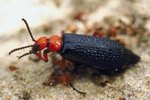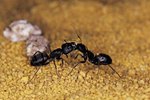
You're playing a game of beach volleyball or maybe you're strolling along the sandy shores. No matter where you step, the sand beneath your feet is the humble abode of two prominent inhabitants: the sand flea and sand fly. While these residents are harmless, fair warning: They can bite.
Sand Fleas
Sand fleas, contrary to their name, are not insects, but crustaceans belonging to the crab and lobster family. Also known as beach or sand hoppers, these critters are so small they're difficult to see with the naked eye. The long-horned sand flea is found in North America, mainly along the Atlantic seacoast. Resembling a shrimp, sand fleas stay buried in sand during the day, only venturing out at night to look for food.
Ankle Biters
Although small dogs are sometimes called "ankle biters," the sand flea is the true ankle biter on the beach. Sand fleas often attack beachcomber's legs around their ankles, especially as they're bent over looking for seashells. Pale-skinned people, because of their thinner skin, are easy targets. Females bite to extract protein from the blood for their egg laying. Sand flea stings cause welts and lesions with pain and itching.
Sand Flies
Sand flies, also called biting midges, are insects (not crustaceans) of which there are hundreds of species found throughout the world. The popular no-see-ums, found in the wetlands, are not related to sand flies found in the southern states and tropics. Sand flies are often confused with sand fleas, but sand fleas only hop and bite your ankle area, while sand flies can fly and bite you anywhere on the body.
Flying Biters
Sand flies, sometimes found near coastal areas in the United States, are especially noticeable in the Caribbean. Like sand fleas, they prey on easy-access flesh as a source of blood. Because they're small they like to look for their meals on calm days with high humidity. You can prevent being bitten by using insect repellents used for mosquitoes.
References
Photo Credits
-
Siri Stafford/Lifesize/Getty Images
Writer Bio
Debra Levy has been writing for more than 30 years. She has had fiction and nonfiction published in various literary journals. Levy holds an M.A. in English from Indiana University and an M.F.A. in creative writing/fiction from the Bennington Writing Seminars.



